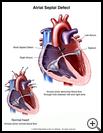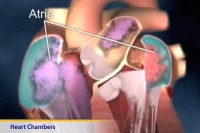
Atrial Septal Defect
What is an atrial septal defect?
An atrial septal defect is a hole in the heart that forms an abnormal connection between 2 of the heart's chambers. It is a birth defect, also called a congenital heart defect. The size of the hole can be very small or it may be more than an inch in diameter.
There are 4 chambers in the human heart. The 2 lower chambers are called the right and left ventricles, and the upper 2 are called the right and left atria. The right atrium receives blood from the veins of the body, and the left atrium receives blood from the lungs. The wall between the 2 atria is called the atrial septum.
When there is a hole in the atrial septum, the higher blood pressure in the left atrium pushes blood through the hole into the right atrium. This adds to the amount of blood in the right atrium. The added volume of blood increases the workload of the right ventricle (the pumping chamber to the lungs). It also increases the flow of blood to the lungs.
How does it occur?
This birth defect happens before birth. Often it is the only defect, but sometimes there are other heart defects as well. Most of the time the cause of the birth defect is not known. A gene defect or something else may keep this part of the heart from developing properly.
What are the symptoms?
Unless the defect is very large or associated with some other defects of the heart, most babies and older children have few or no symptoms. In fact, many people may live their entire lives with a small atrial septal defect and not know they have it. It may be found only when they are being tested for something else.
Large defects may cause symptoms. The extra blood flow through the lungs may increase the blood pressure in the lungs. This may cause heart failure. Possible symptoms of heart failure are:
- shortness of breath
- faster breathing rate
- cough
- swollen legs or ankles
- decreased growth.
Sometimes the heartbeat is irregular because of the added strain on the heart.
How is it diagnosed?
After a physical exam, your child may have the following tests:
- chest X-ray
- electrocardiogram (ECG or EKG), which is a recording of the electrical activity of the heart
- echocardiogram, which is a type of ultrasound scan
Large defects cause a heart murmur that can be heard with a stethoscope. A heart murmur is an extra sound heard between heartbeats. Also, increased blood flow through the hole may make the heart get bigger. The enlarged heart can be seen on a chest X-ray or on an electrocardiogram.
If the defect is small, a heart echocardiogram may be the only clue to its presence. This ultrasound test bounces sound waves off the heart to create a detailed picture of the heart and its structures. It is a painless procedure that can be done in a healthcare provider’s office.
Sometimes heart catheterization may be needed. A catheter is a very thin tube that is passed through a blood vessel into the heart. The pressure in the chambers of the heart is measured and blood samples can be taken. This helps diagnose a defect and can tell how big the defect is.
How is it treated?
If the defect is not causing any symptoms, treatment depends on how much blood flows through the hole. If it is a very small amount, there may be no benefit to having the hole closed. If a lot of blood flows through the hole, it should probably be closed.
If the defect is causing symptoms, a procedure to close the hole may be needed.
Often the defect can be fixed by pushing a flexible plastic device through a leg vein and into the heart, where it can be used to plug the hole. Sometimes open-heart surgery is needed to sew the hole shut or patch it. A small piece of tissue from the sac surrounding the heart may be used for a patch.
In general, it is best to close the defect at a younger age before the heart or lungs are damaged. Your healthcare provider will advise treatment based on the symptoms and size of the defect.
How long will the effects last?
A small defect may never cause any symptoms or problems. It may close on its own during the first years of a child’s life.
If a defect is large and not closed with surgery, it can cause problems such as heart failure. Even if a defect is not causing symptoms, your healthcare provider may suggest closing it because it may cause problems over time. It could also increase the risk for stroke.
Many people with congenital heart defects can live normal lives. Some may need to limit their activities and take medicine the problem.
How can I take care of my child?
If your child has an atrial septal defect and no symptoms, he or she should have regular checkups. Your child may need to have regular follow-up visits with a specialist in congenital heart disease.
Ask your healthcare provider if your child should take antibiotics to prevent infection before having dental work or procedures that involve the rectum, bladder, or vagina.
Call your child’s provider if your child:
- gets short of breath more often
- wakes up at night short of breath
- has a bluish color around the lips and mouth
- has an irregular heartbeat
- has trouble feeding or has a poor appetite
- has a fever lasting more than 2 days
Last modified: 2011-06-15
Last reviewed: 2011-06-06


